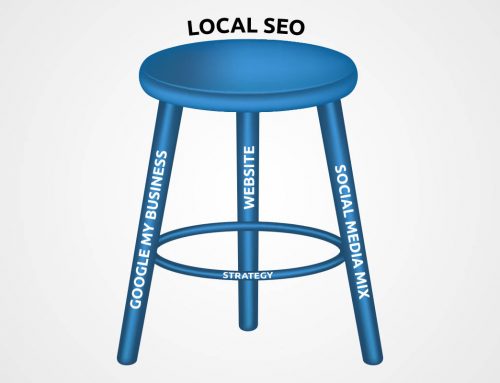
2020 Marketing
(10) Decem Digital Do’s Entering the New Decade
If you feel the last ten years went by fast and that technology has changed the way businesses promote their business more than any other time, just wait unto the next decade! With the winding down of the current year, it’s a great time to review how you feel the year has gone and put plans in place to shift in to the 2020 gear.
While it can be exhausting for businesses to constantly chase the latest and greatest trends, there are absolutely aspects related to marketing that – if not put in place – will leave you at a significant disadvantage going forward. This list of Do’s isn’t a list of trends, rather established aspects in marketing based on how consumers are responding. Technology has made myriad advances in the consumer experience and abilities for businesses to engage. There are even more blogs out there about those advances you can go to if you’re interested in things like “voice search” and “AI” integrations in marketing.
Consider this article as a checkup to make sure you have some of the key fundamentals in place before wandering into lists of trends out there you could also benefit from.
“Don’t mistake activity for achievement.” – John Wooden
1. Online Reviews
Despite all the evolving forms of marketing (radio, TV, newspaper, online search, phone books, etc), the most powerful source of success for any brand is in word-of-mouth. Initially, online reviews – a modern form of word-of-mouth – was viewed as a negative from the perspective of many businesses. The “Yelp stigma” still has many equating online reviews with customer complaints or (worse) active negative campaigns to bring competition down. Over the last few years, however, businesses have learned how to harness the power of reviews. Rather than waiting for customers to go leave reviews, they’ve become pro-active in soliciting reviews. Google reports the average review scores over recent years has gone up 12%! With the mixture of Google Reviews, Facebook Recommendations, YouTube testimonial videos, Bing Reviews, Yahoo Reviews, Yelp, and reviews across multiple industry specific ratings sites, consumers are appreciating the wealth of peer feedback they can turn to when making critical decisions. As covered in a previous article, review management is critical for businesses to retain and attract customers.
2. Local Listings/Citation Management
“Name, address, phone number, categories of services.” As a former peddler of phone book ads, this was something I repeatedly verified with businesses as we renewed their annual contracts for ads and listings throughout our directories. Today, dozens of key (and many more) online listing sites store the names, address, phone numbers, categories of service/products, and URLs of businesses all over the world. Managing them independently can be a nightmare, which is why including Citation Management in a marketing plan will ensure your contact info remains accurate. Search engines reference these online sources to help confirm your business lines up with what is being searched for based on keywords and locality.
While there are many, the primary listing sites most are familiar with and that carry more weight are: Google My Business, Facebook Business Page, Yelp, EZLocal, and Foursquare. Even sites like Über, Lyft, and car manufacturers are accepting citations data to help with increased accuracy for their navigation systems.
These websites – with or without you – are seeking whatever data they can to provide their searchers with information, however, they are not always correct. It all depends on the source of their data. Citation Management ensures your information is correct and that people aren’t provided the wrong contact details when they need your services.
3. Personalized Marketing Campaigns
Use the intelligence from all the individual online habits, behaviors, interests, and searches accumulated online to your advantage. You’ll get more out of your marketing budget by increasing its accuracy, and consumers will respond more to what they’re interested in than marketing that is pushed on them.
For example, a consumer might watching movie previews – even searching show times – throughout the week. By Friday or Saturday, typical date nights, that same person might start searching for “restaurants near me”. On top of that, Facebook shows the person is married. If your business is an ice cream shop, you could target them with Facebook ads about “It’s date night. After escaping for dinner and a movie, don’t forget desert.” Similarly, you can have digital display ads aimed for potential appearance on YouTube and Google display network, hoping to anchor your place in their minds as the place to go for desert. Maybe your ad will actually show up during one of the movie previews they watch while deciding which movie to go to.
4. Don’t Create. Document.
If you haven’t already dabbled in and experienced the positives of social media platforms for your business, it’s never too late to start. Depending on which type of business you are, some platforms will serve you better than others. For example, if your business has services/products that are visual, Instagram, Facebook, and YouTube are great for displaying what you have to offer. A company with more intangible services could benefit from more of a case study approach with shares on LinkedIn to develop expertise.
Decades before this digital time seems to have developed the habit of businesses trying simply to create an experience through a catchy ad. While some of that still exists, those businesses who are able to get the most out of their marketing, though, have developed greater levels of brand trust through efforts in connecting online. By sharing about their brands and learning from the reactions of the consumers through the variety of platforms, getting the messaging right for the ads has become less of a brand outward push, and more of a sealing the deal with a group they’ve already connected with.
Examples of documentation vs creation:
5. Video Increases Ability to Connect More
Like no other form of media before, the invention of the television and various forms of video available today is successful due to it’s ability to connect with two senses that play a significant role in connecting with consumers: visual and audible. From the standard 30-60 second commercials used by TV for decades to 5-second bumpers and 2-3 minute long videos used today, video can accomplish more in less time than other forms of content used to reach consumers.
While YouTube and other online video options have been more readily utilized in national brand marketing efforts, local businesses should give more consideration to where they are paying to have video marketing shown for their businesses. Nielsen data – which marketing groups and local stations have referenced in validating demographics and audience size for certain shows to advertise during has also tracked the depletion of effectiveness of cable and broadcast TV and the increase of CPM (cost per thousand impressions) during the decline in TV viewing. [Think with Google article: Total Ad Ratings reveal YouTube reaches what TV misses)
As you review marketing efforts and talk budgets and ROI with your team, consider this graph:

Key: 18-49 GRPs1 | Broadcast CPM2 | Cable CPM2
Sources: 1Nielsen, Npower Reach & Frequency Report | 2MDI Mediapost/Statista
What’s most significant for the local/small business when looking at the above graph is how broadcast advertising is increasing at a far greater rate per thousand impressions than cable. While I understand the misconception that online video marketing is too grandiose for the small business, this data shows there’s greater potential for local businesses to save and re-allocate marketing dollars than those relying more on cable advertising. As you consider video marketing options, here are platforms to consider starting out on to get the most result:
YouTube is cross-generational. The majority of Americans are viewing YouTube frequently, regardless of age.

With YouTube, you can take effective and still relevant TV commercials and begin transitioning them to a YouTube channel for your business. There may be some you could use to run as video ads on YouTube that begin playing before content being watched by viewers. If you don’t have video yet to use this way, there are display ads you can setup to appear over the bottom of videos being watched by potential customers.
Similarly, you can share videos on Facebook and Instagram and pay to have them boosted to be seen by a greater audience. Unlike traditional video marketing, where you try targeting commercials to shows your typical customer watched, video marketing on YouTube, Facebook, and Instagram allow you to target viewers based on their search history, interest in your services, and/or based on the content they’re watching – among other things. You can also setup multiple campaigns to deliver ads (video or graphic) based on what you feel would best fit the situation of the viewer.
Example: If you’re a lender for home loans, you could deliver ads for mortgages to people who are actively searching homes in the area, provide refinance ads to people who might be looking for ways to get out of debt or pay off credit cards, and show a different refinance message to someone who is researching costs for home improvements.
This drop in viewership on television is an even more significant punch in the gut to TV ads than DVRs could have imagined being. With this shift, you’re seeing more national brands injecting their products into movies and TV shows. And we’re going far beyond the simple inclusion of Reese’s pieces in ET or Marty McFly wearing Nike shoes. Viewers find themselves hearing a commercial embedded into a script or watching a walk-around video of a truck that covers the sleek lines and amazing features of a Tundra. This is an expensive and complex means to get products in front of consumers.
Simpler, and far more affordable to the local/small businesses are tying the bumper and display ads for YouTube and boosting videos on social media. Own a mechanic shop? Run display or short video ads when someone (like me) looks up a “How to” video on a basic car repair. You may not earn the DIY person’s business in that instance, but can certainly develop brand recognition over time and be far more likely to get their business when the job becomes more than can be done on their own.
6. One Word: Google
If you’re a local business – even in a small community, don’t under estimate the importance of having a solid presence in the areas Google provides support. With the significant drop off in use of phone books, even consumers in the smallest of communities across the country are relying on search (primarily on a smart phone) to find what they’re looking for. If you feel discouraged that the national chains are dominating, it’s only because they are taking advantage of the tools many small businesses are either not aware of or simply don’t understand the power of. In reality, local search holds significant weight in driving business to either a local company or online company.
Check out these recent stats that are local-first empowering:
46% of ALL Google searches have a local intent. (Hubspot)
Just under half of all searches online are consumers looking for something to do, to eat, or to buy in their city.
93% of local searches now feature Google My Business listings (STAT Analytics)
This is one of the myriad local citations, but it’s the primary means for the largest search engine to show details about your company to consumers. Google My Business includes details such as: Name, Address, Phone Number, URL, Hours of Business, Categories of Services/Products, Images, Reviews, Cost factors, Q&As – details answered by consumers to increase accuracy, Popular Times based on actual volume of traffic to your location, Links to other profiles you have online.
68% of people contact a business directly from search results. (Search Engine Land)
A decade ago, the focus was getting traffic to your website to make a conversion. Now, most conversions are happening based on
88% of people trust online reviews as much as personal recommendations (Forbes)
Simply put, a well executed local brand presence is ripe with opportunity.
7. Three Areas Emails Can Prove Profitable
How are you using email to engage potential and current customers? Unfortunately, many small businesses only seem to hit the send button in emails related to efforts to sell services/products or to bill the customers. These three buckets (we’ll call them) for using emails are proving effective for business.

As much as you can, throughout your efforts at each of these stages in the customer journey for your business, you need to focus on #3 and personalize. Referring to Dale Carnegie, use the customer’s name. Take what you know – our your CMS system knows – about them and deliver content most pertinent to them.
Engage – Hundreds, even thousands, of emails of potential customers can linger in this segment of your customer journey. Find ways to educate them about the industry and continue building brand trust. Often times, you’ll educate them on what to look for and not ask for their business directly in the email. You’ll offer a consult, which gives you the window of opportunity to visit with them and determine if things are a good fit or not. Other times, you will send emails that are purely promotional. But, engagement stage emails cannot always be about getting the sale. This is a quick way to guarantee increases in unsubscribed members of the list.
In 2019, businesses surveyed in North America, Europe, and Pacific Asia reported email marketing being among their top three for effectiveness in:
Building Visibility and Awareness (40%)*
List Acquisition (40%)*
Engagement/Lead Nurturing (68%)*
Continue building the list of emails and contacts for your Engage stage. You can do this by asking people to subscribe to your blog and provide their email for updates. Run occasional social media campaigns asking for emails to provide people updates on your industry. Possibly explore lead lists you can purchase if you’re struggling to generate some on your own. (Note: With that last option, be sure to send an email inviting them to opt in for future emails.)
Conversion – Whether an entirely new sale, an up-sell, or repeat sale to a customer, emails have proven powerful in driving conversions. Timeliness and personalization in the emails increase your ability to generate a conversion exponentially. As you nurture and engage contacts, track what subscribers are more or less likely to engage in to help determine segments you can put them in to improve your ability to connect with them and eventually earn their business or increase the amount of business you’re already doing with them.
Most Effective Channels for Conversions (53%)*
Retention – When it comes to customer retention and loyalty, email is in a category far above other means of success. Several businesses make the mistake of pressing hard up until the point of purchase, then assume the battle for business is won. Data shows consumers are becoming less loyal to particular businesses (especially online) and more likely to purchase based on price, convenience, and influence from reviews or testimonials. After becoming a customer, creating a social following and building in email campaigns/workflows/sequences to continue engaging them is crucial in maintaining their business.
Emailing them newsletters or articles to maintain brand authority, sending occasional surveys after purchases, or emailing them to ask for a review are some basic methods you can include in your retention and loyalty building efforts.
Customer Retention and Loyalty (71%)*
Top Customer Engagement Platforms (79%)*
8. Automation
While at a business conference, I heard the comment: “The less you find yourself doing in your business, the more successful you’ll be.” Many might see this as simply a concept applicable to businesses delegating responsibilities to their managers and employees. For small businesses and even large businesses, leveraging automation from simply form responses to more complex and specified campaigns can significantly magnify the amount of engagement your company can accomplish. Basic CRM systems to the more complex allow you to categorize leads/customers by interests and behaviors to nurture your customer relationship with them.
Surprisingly though, automation is highly underutilized. Even the most popular of the options listed below from the London Research survey is used by only less than half of businesses:
9. AI – Chatbots
AI doesn’t have to be extremely complicated or impersonal. Think about the FAQs pages some may continue building out of their website. While FAQs can benefit your business for search purposes and be helpful with visitors doing so deep research about your business. For most visitors to your website, however, a chatbot programmed with responses to common questions (or FAQs) can aid in leading them to the content most valuable to them at the time. There are free and paid versions of chatbots you can explore to determine which will provide your site visitors with the most ideal experience and be of greatest benefit to you. Chat messaging can also be automated on various social media platforms.
Chatbots are great for responding to visitors after hours and directing visitors the page most specific to their interests in visiting your website. In fact, Google Trends shows the use of chatbots has increased 19x over the last five years due to individuals and businesses realizing the value in them. Here are some key use cases of how businesses are using messaging and chatbots to assist visitors:
Getting a quick answer in an emergency
Resolving a complaint or problem Getting detailed answers or explanations Finding a human customer service assistant Making a reservation (e.g. restaurant or hotel) Paying a bill Buying a basic item Getting ideas and inspiration for purchases Adding yourself to a mailing list or news service Communicating with multiple brands using one program (None of these things) Buying an expensive itemSources: 2018 State of Chatbots Report: sproutsocial

To help determine how a chatbot could be used on your website and social media platforms, brainstorm the various questions often handled via email, phone, or responded to from form completions. Look to where traffic is dropping off on your website and consider engaging chat messages that might help you retain them on your site longer and assist in leading to a conversion on that page.
10. Social Media
From the charts included in the section about emails, you’ll notice social media carries significant weight when it comes to engaging, converting, and retaining customers. Depending on your product/services, certain platforms will serve you better than others. For example, B2B is most likely to have a stronger presence on LinkedIn than on Instagram. Consumer products, on the other hand, tend to perform better on Facebook and Instagram than on LinkedIn. And YouTube works quite well for both the B2B and B2C companies.
Social Media provides you an outlet to go beyond the brand messaging on your website and continue engaging and building rapport with consumers. Beyond that, you have more freedom to develop and share the brand personality through videos, post, and comments shared through these social media pages. This relationship, built over time, can lead to significant levels of conversions when you consider 77% of consumers are likely to purchase from brands they follow. Having a following helps with maintaining brand authority and top-of-mind awareness.
77%
of consumers are more likely to by from brands they follow on social.
Sprout Social
The personality you portray online helps attract customers/clients/patients you’re best suited to do business with, so as you look at what most consumers expect from the brands they find online, look to your company’s ‘WHY’/purpose and look to strategies to help draw your messaging into a personality that connects.
Behaviors Consumers Want From Brands on Social
Source: socialsprout – Q2 2017
But, don’t get lost in social media. If you find one platform more effective than the other, increase engagement there and make occasional shares/posts to the less effective. Boost posts that seem to resound best with potential and current customers (which you can track by likes and shares) and be sure to target profiles who best match your current customers and page followers to get the greatest returns.
Summary
Despite the reluctance businesses may have in transitioning to more digital, it provides for the greatest amount of diversity and agility in achieving marketing goals and objectives. Consider the former “traditional” marketing efforts and what would be required to make changes and adapt messaging based on effectiveness.
Here’s an extreme example: Years back, there was a car dealership I have frequented locally that had a phone number incorrectly published in a phone book. While the local number was correct, the toll free number was not to their business, rather a hotline. Yep… a hotline. For an entire year, any potential customers that would call the toll free number instead of the local number to schedule service or even call to ask about cars on the lot were answered with a sultry voice. Of course, long distance calls and phone books to look up numbers are both almost non-existent today but it does illustrate the restraints on a business in being able to change information. With digital, typos don’t become year-long, month-long, week-long, or even day-long points of harm to a business. In most cases they can be corrected as quickly as they’re discovered.
The future of marketing is more digital and coming sooner than you might expect. By 2022, CMO predicts (based on current trends) that 87% of total marketing budgets will be spent digitally. The beauty in all this change, is now more than ever, consumers are driving what does or doesn’t work for businesses. As a company, you only need to track what’s most effective for you rather than continue in the routine of renewing marketing without really knowing if it’s working or not.






